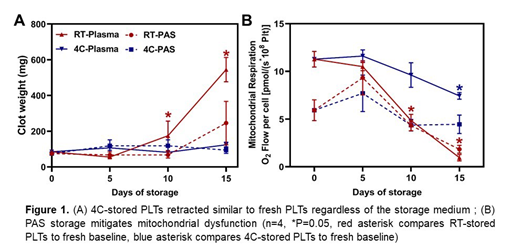Background: Platelet (PLT) hemostatic responses are heavily dependent on PLT bioenergetics which drives the generation of PLT contractile forces and contribute to mechanical hemostasis. Although effective clot retraction (CR) requires PLT adhesion, aggregation and formation of strong clots, CR remains an understudied PLT function. In this work, we hypothesize that well-conserved PLT bioenergetics during storage is crucial for highly energy-dependent PLT functions including CR. To further investigate this correlation, we characterized the effect of extended PLT storage for up to 15 days on PLT bioenergetics and CR at room temperature (22°C, RT) and refrigeration (4°C, 4C).
Methods: Apheresis PLT concentrates in plasma were collected from 5 healthy donors and stored for 21 days at RT with agitation, or stored stationary in the cold (4C). Fresh PLTs were treated with metabolic inhibitors for 1 hour at 37°C, recalcified with 20mM calcium chloride, and incubated at 37°C to initiate CR. The clot weights were measured post retraction, and the clots were prepared for immunohistochemistry to assess clot structure. Similarly, extent of retraction and mitochondrial respiration levels were estimated in PLTs stored for 5, 10 and 15 days. Additionally, Platelet additive solution (PAS) stored PLTs were tested as a viable alternative to plasma storage to improve metabolic exhaustion during storage.
Results: 4C-stored PLTs in plasma retracted similar to fresh PLTs for up to 15 days. In comparison, RT-stored PLTs in plasma did not retract after 10 days, whereas PLTs stored in PAS at RT or 4C seemed to retain their contractile function for up to 15 days (Fig 1A). 4C-stored and fresh PLTs yielded heavier clots with a highly organized structure compared to the disorganized structure of clots from RT-stored PLTs. Mitochondrial respiration was significantly reduced over 10 days in RT- plasma stored PLTs, which was mitigated by PAS storage. Similarly, 4C storage in PAS mitigated the reduction in respiration seen in 15 days 4C- stored PLTs in plasma (Fig 1B).
Conclusion: Retraction properties of 4C-stored PLTs were similar to those of fresh PLTs, together with superior clot structure and function compared to RT- stored PLTs. This suggests that 4C storage could be a suitable alternative for extended storage. In RT-stored PLTs, reduction in mitochondrial respiration did not show any correlation with the reduced ability of PLTs to retract, suggesting that preserved glycolysis in PAS- stored RT-stored PLTs enabled CR. Thus, storing PLTs in PAS at RT or 4C could potentially mitigate mitochondrial dysfunction during extended storage.
No relevant conflicts of interest to declare.
Author notes
Asterisk with author names denotes non-ASH members.


This feature is available to Subscribers Only
Sign In or Create an Account Close Modal